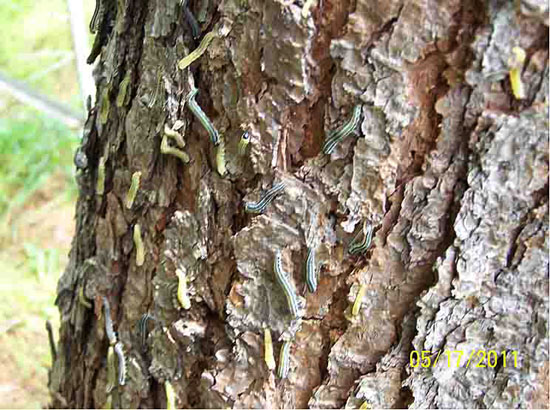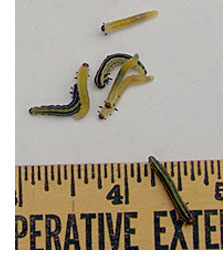Issue 5, May 23, 2011
Red Pine Sawfly
We have received a couple of reports of heavy feeding on loblolly and Eastern white pine in Harrisburg and Vienna in southeastern Illinois by what appears to be red pine sawfly larvae, Neodiprion nanulus nanulus. Large numbers of white worms are being reported on the foliage and trunks of the trees.
Red pine sawfly feeds primarily on red and jack pines, but also is known to feed on eastern white, Japanese red, and Swiss mountain pines. Full-grown larvae are about three-fourths inch long with black heads. They have a thin yellowish-white stripe down the back bordered by olive-green stripes. There are also two dark stripes on each side and a thin dark stripe just above the prolegs. The underside and area between the stripes are greenish-white. Younger larvae have black heads and yellowish-white bodies without stripes.

 Eggs overwinter and hatch in early May. Larvae can be present as late as July and August. They feed as groups of larvae, feeding on the two and three year old needles. As a group eats all of the older needles in one area of a tree, they migrate to another branch, resulting in their commonly being seen on the trunk. Full-grown larvae drop to the ground and pupate in fallen needles and debris under the tree. Adults, which look like small wasps, emerge in early fall to lay eggs in the first year needles left behind by the larvae.
Eggs overwinter and hatch in early May. Larvae can be present as late as July and August. They feed as groups of larvae, feeding on the two and three year old needles. As a group eats all of the older needles in one area of a tree, they migrate to another branch, resulting in their commonly being seen on the trunk. Full-grown larvae drop to the ground and pupate in fallen needles and debris under the tree. Adults, which look like small wasps, emerge in early fall to lay eggs in the first year needles left behind by the larvae.
Although the larvae usually do not eat the current year's needles, they will do so if older needles become scarce. Completely defoliated branches typically die. Loss of the older needles on the tree for several years in succession can cause a loss of overall tree vigor and attack by bark beetles that may kill the tree.
Because the larvae feed in groups, they are easily removed by hand on smaller trees. Spraying with acephate (Orthene), azadirachtin (Azatin, BioNeem, Ornazin), carbaryl (Sevin), spinosad (Conserve), or other labeled insecticide will also be effective. (Phil Nixon)
Author:
Phil Nixon